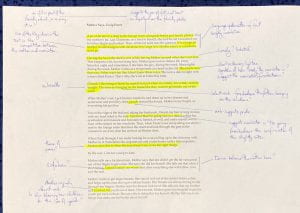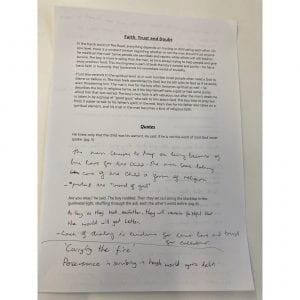Please note this blog post is based on an extract from Mother Says by Craig Ensor. The short story is attached.
Here is my response, which is incomplete:
Question:
How are language features used to construct the voice of the narrator in Text 1?
Through the use of powerful verbs and personification, the voice of the narrator in Text 1 is constructed as determined and focused.
The first sentence establishes the determination of the narrator, who is going to ‘pierce’ their ears. The verb here suggests pain which is contrasted in the next sentence by the assurance that they’ll ‘feel better’ about themselves as a result. The age of the narrator is perhaps revealed by the simile in which they describe the dots drawn on their ears as looking like ‘unsqueezed blackheads’ and their apprehension is further developed by the personification of the needle which ‘panics’ in their hand. Despite this reticence, Ensor continues to use powerful verbs to show the narrator’s determination. The needle is pushed through the earlobe and the flesh ‘tears’. This verb is significant for two reasons; firstly, it suggests the damage the narrator has done, but it also suggests the focus and determination to complete the process, despite the pain suggested by the language.
Here are my teaching and learning points and things to note:
- The first sentence acts as a thesis statement. It is short, concise and focused. It offers a direct response to the question and confirms I’ve read and understood it.
- Note the short quotations that have been used. There are several quotations and the longest one is two words. You will not be efficient in your exam if you are having to copy out large tracts of text. A short quotation also produces more focused analysis.
- There is very little plot narration. Assume that your examiner is familiar with the text.
- There is no repetition of ideas. I make a point and then move onto a different one. You will lose marks in your exam if you repeat yourself and summarise comments already made.
- There is reference to specific language features.
- The response attempts to link these language features to show how they all develop a central idea about the narrator.
- Note the use of the phrase ‘their apprehension is further developed’ which links one language feature with another.
- Note that I’ve also modelled how one language feature works on multiple levels. In other words, the text has layers of meaning. Always look for the potential that a language feature is doing more than one job.
So… what is the effective structure for a Comprehending Section response?
-
There are no hard and fast rules about structuring your responses;
-
Some students choose to write a very brief introduction in the form of a thesis statement at the start. I would encourage you to do this because it helps focus your ideas into something that is cohesive and controlled;
-
You are advised against writing a conclusion in a short answer response. As conclusions act as a summary, you won’t be rewarded for saying the same thing twice. You will actually lose marks for repetition.
-
Usually, you would write one lengthy paragraph in which you LINK specific textual/visual features and demonstrate your comprehension of the text/image you are writing about. Some students choose to write two or three shorter paragraphs that split their response into several aspects. Either way is FINE as long as you write CLEARLY and SUCCINCTLY
Comprehending Mother Says
ANNOTATED Mother Says Extract









